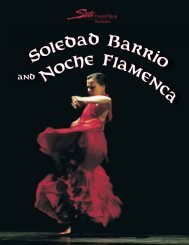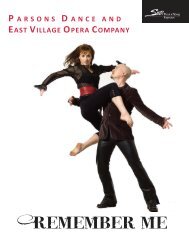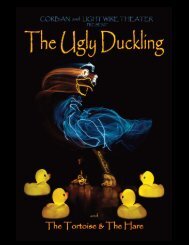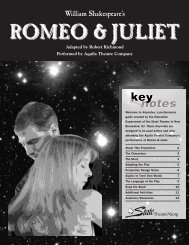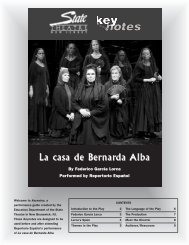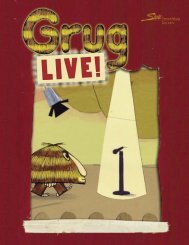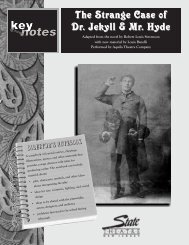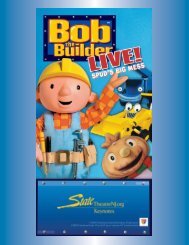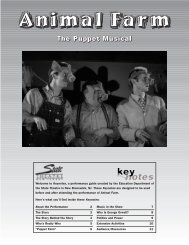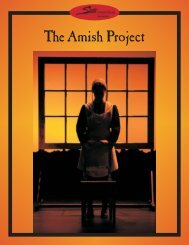Drumline 2011 Keynotes:Layout 1.qxd - State Theatre
Drumline 2011 Keynotes:Layout 1.qxd - State Theatre
Drumline 2011 Keynotes:Layout 1.qxd - State Theatre
You also want an ePaper? Increase the reach of your titles
YUMPU automatically turns print PDFs into web optimized ePapers that Google loves.
Welcome to the show! 2<br />
The <strong>State</strong> <strong>Theatre</strong> in New Brunswick, New Jersey welcomes you<br />
to the school-day performance of DrumLine Live! This live<br />
theatrical performance is inspired by the traditional marching<br />
bands of America’s historically black colleges and universities<br />
(HBCUs). While the show was created by the same musical team<br />
responsible for the popular film <strong>Drumline</strong>, it is NOT a stage<br />
version of the movie: there’s no story or characters—just music,<br />
marching, and an eye-popping spectacle of colorful costumes and<br />
choreography. Presenting marching band arrangements of more<br />
than a century’s worth of American popular music, the<br />
performance draws on diverse cultures, societies and historical<br />
periods, encompassing rhythm and blues, jazz, pop, and hip hop.<br />
These <strong>Keynotes</strong> describe many of the songs and instruments<br />
used in the performance. You’ll also find cultural and historical<br />
background on HBCUs and their marching bands.<br />
CONTENTS<br />
Welcome to the Show! ............................................................2<br />
The Program ................................................................................3<br />
Musical Highlights ......................................................................4<br />
Marching Bands ..........................................................................5<br />
The <strong>Drumline</strong> ................................................................................6<br />
HBCUs..............................................................................................7<br />
Percussion ......................................................................................8<br />
Brass ................................................................................................9<br />
Woodwinds ................................................................................10<br />
Get Ready! ..................................................................................11<br />
<strong>Keynotes</strong> are made possible by a<br />
generous grant from Bank of America<br />
Charitable Foundation.<br />
The <strong>State</strong> <strong>Theatre</strong>’s education program is funded in part by Bank of America Charitable Foundation, Colgate-<br />
Palmolive, The Geraldine R. Dodge Foundation, E & G Foundation, Gannett Foundation, The William G. & Helen C.<br />
Hoffman Foundation, The Horizon Foundation for New Jersey, Johnson & Johnson Family of Companies, J. Seward<br />
Johnson, Sr. 1963 Charitable Trust, Karma Foundation, The Blanche and Irving Laurie Foundation, McCrane<br />
Foundation, MetLife Foundation, Mid Atlantic Arts Foundation, National Starch, New England Foundation for the<br />
Arts, New Jersey <strong>State</strong> Council on the Arts, Pennsylvania Performing Arts on Tour, PNC Foundation, Bill & Cathy<br />
Powell, The Provident Bank Foundation, PSE&G, Robert Wood Johnson Foundation, TD Bank, and Wachovia Wells<br />
Fargo Foundation. Their support is gratefully acknowledged.<br />
The presentation of DrumLine Live! is supported by PSE&G.<br />
Funding has been made possible in<br />
part by the New Jersey <strong>State</strong><br />
Council on the Arts/Department of<br />
<strong>State</strong>, a partner agency of the<br />
National Endowment for the Arts.<br />
Continental<br />
Airlines is the<br />
official airline<br />
of the <strong>State</strong><br />
<strong>Theatre</strong>.<br />
The Heldrich<br />
is the official<br />
hotel of the<br />
<strong>State</strong> <strong>Theatre</strong>.<br />
<strong>Keynotes</strong> are produced by the Education<br />
Department of the <strong>State</strong> <strong>Theatre</strong>,<br />
New Brunswick, NJ.<br />
Lian Farrer, Vice President for Education<br />
Online at www.<strong>State</strong><strong>Theatre</strong>NJ.org/<strong>Keynotes</strong><br />
<strong>Keynotes</strong> for <strong>Drumline</strong> LIVE written and designed by<br />
Jennifer Cunha.<br />
Edited by Lian Farrer and Katie Pyott.<br />
© 2010 <strong>State</strong> <strong>Theatre</strong><br />
Find us at www.<strong>State</strong><strong>Theatre</strong>NJ.org<br />
Contact: education@<strong>State</strong><strong>Theatre</strong>NJ.org<br />
The <strong>State</strong> <strong>Theatre</strong>, a premier nonprofit venue for the<br />
performing arts and entertainment.
The Program 3<br />
ACT I<br />
The <strong>Drumline</strong> is Born<br />
The musical journey begins with the ancient rhythms of<br />
the world’s first drummers, brought up to date in the<br />
sound and fury of a mighty new band of musicians.<br />
Shout It Out!<br />
Nobody can sit still when these all-star musicians and<br />
dancers strut their stuff. So get up, get loud, and shout it<br />
out: there’s a band in the house!<br />
Soul Mates<br />
The<br />
Some call it Motown. Some Motown<br />
call it soul. The sweet,<br />
record label is<br />
smooth sounds<br />
named for its<br />
hometown: Detroit, Michigan,<br />
defined an<br />
the center of America’s auto<br />
American musical<br />
industry (“Motor<br />
genre with songs made<br />
Town.”)<br />
famous by some of the<br />
greatest recording artists of all<br />
time.<br />
ACT II<br />
Swing Town<br />
If you dig the sounds of the big bands of the 1930s and<br />
1940s, you’ve come to the right place! Welcome to Swing<br />
Town. Open twenty-four hours. Bring your dancin’ shoes!<br />
Halftime!<br />
This is a tribute to the halftime extravaganzas made<br />
famous by the historically black college and university<br />
marching bands from across America. Who needs a<br />
stadium<br />
American Jazz Jubilee<br />
The ensemble pays homage to the musical treasures of<br />
their past in this celebration of American jazz. Let’s make<br />
some noise!<br />
Drum Crazy<br />
Ghostly drummers take<br />
over the stage with some<br />
magical fun and crazy rhythm.<br />
You’ve never seen a drumline<br />
like this before!<br />
Gospel Celebration<br />
Put on your Sunday-go-tomeetin’<br />
clothes for a handclapping,<br />
heart thumping<br />
celebration of America’s<br />
Southern gospel music.
Musical Highlights 4<br />
DrumLine Live features nearly 40 songs that span more than a century of America’s musical history. Here is a sample of<br />
some of the music you’ll hear in the show, with links to video clips that you can check out before attending the performance.<br />
“Go Tell It on the Mountain”<br />
This song was written by John W. Work sometime around<br />
1865. It is an African American spiritual, a type of religious<br />
folk song originated by African American slaves. Spirituals<br />
could carry hidden messages of protest or express the<br />
hope of a better life through religious faith. ”Go Tell It on<br />
the Mountain” is a joyful Christmas song: “Go, tell it on the<br />
mountain,/Over the hills and everywhere/Go, tell it on the<br />
mountain,/That Jesus Christ is born.”<br />
“It Don’t Mean a Thing”<br />
”It Don’t Mean a Thing” was<br />
In<br />
composed by Duke Ellington<br />
1977,<br />
Stevie Wonder<br />
in 1931 for his big band.<br />
wrote “Sir Duke,” a tribute<br />
The lyrics are by Irving to Duke Ellington. The song<br />
Mills. This song became<br />
is also featured in<br />
Ellington’s signature tune and<br />
DrumLine<br />
Live.<br />
brought the word “swing” into<br />
everyday language. The major style of<br />
popular music from about 1935 to 1945, swing was a type<br />
of jazz that featured a “swinging” rhythm that was perfect<br />
for dancing.<br />
“Baby Love”<br />
The Supremes, a female<br />
singing group led by Diana<br />
Ross, recorded ”Baby Love” in<br />
1964 for the Motown label.<br />
The song spent four weeks on<br />
the Billboard Hot 100 singles chart. Motown was the first<br />
record label owned by an African American and promoting<br />
African American artists. The company developed a<br />
distinctive sound that helped African American soul music<br />
cross over into the wider pop music market.<br />
“I Want You Back”<br />
Pop music superstar<br />
Michael Jackson first<br />
gained fame as the 11-<br />
year-old lead singer of<br />
the Jackson 5, a vocal<br />
group consisting of<br />
Michael and brothers<br />
Jermaine, Jackie, Marlon, and Tito. In 1969, the group<br />
scored their first number-one single on the Motown label<br />
with the up-tempo ”I Want You Back”.<br />
“Shining Star”<br />
The Chicago-based band Earth, Wind<br />
& Fire had their first and only #1<br />
Other<br />
hit in 1975 with ”Shining<br />
funk music<br />
Star”. The song belongs<br />
legends: George<br />
to the funk genre—an<br />
Clinton, Bootsy Collins, the<br />
Commodores, Sly & the<br />
African-inspired blend of<br />
Family Stone,<br />
soul, jazz, and R&B that<br />
and War.<br />
emerged in the mid-1960s. Along<br />
with a funky, danceable bass groove,<br />
the arrangement features a full horn section.<br />
“Cold Hearted”<br />
Best known today as a judge on television’s American Idol,<br />
Paula Abdul began her career as a Los Angeles Lakers<br />
cheerleader and went on to become an Emmy- and<br />
Grammy-winning singer, dancer, and choreographer. The<br />
pop hit, ”Cold Hearted” (sometimes known as “Cold-<br />
Hearted Snake”), appeared on her 1989 multi-platinum<br />
album, Forever Your Girl. The song was written by Elliot<br />
Wolff.<br />
Listen Up!<br />
Listen to each of the songs by clicking the link. Do you recognize any of them Where have you heard them<br />
before Take time to listen to the songs multiple times. Can you identify any specific instruments or rhythms<br />
Which of these songs do you think will sound best played by the marching band in DrumLine Live How<br />
faithful to the original versions do you think the performance will be Do you think it’s important for them to<br />
sound like the original, or is it more important for them to put their own spin on the music
Marching Bands 5<br />
Marching bands evolved out of<br />
military bands. Originally,<br />
instruments such as drums and<br />
bugles were used to direct the<br />
movement of troops on the battlefield<br />
or set a marching pace for soldiers.<br />
Many aspects of military bands survive<br />
today in marching bands—from the<br />
commands used to direct the formation (“About face!”<br />
“Forward march!”) to the precision-drilled marching<br />
formations and military-style uniforms. As music became less<br />
important in battle, military bands were increasingly used for<br />
ceremonial occasions and public concerts. New instruments<br />
were invented, and composers such as Johann Strauss and John<br />
Philip Sousa wrote music for brass and military bands.<br />
Field musicians, particularly the drummers, had a long history<br />
of staging drumming competitions to demonstrate their skill.<br />
Separate from the military bands, these demonstration<br />
parade units consisted of the traditional field music units and<br />
color guards bearing rifles and swords. After World War II, the drum corps (bugles,<br />
drums, and color guards) shifted from parade activity to field shows. The field,<br />
often an athletic playing field, provided the space for more ambitious and<br />
complex demonstrations of marching maneuvers.<br />
Today’s marching bands typically include brass, percussion, and<br />
woodwind instruments. Some marching bands can have upwards of 300<br />
members—plus dancers and color guard. The band featured in DrumLine Live!<br />
consists of about 30 band members and 5 dancers. They are a show band, the<br />
type of band most commonly seen during football halftime shows.<br />
You can get an idea of oldstyle<br />
American military<br />
drumming by watching a<br />
sample by the Army Band’s<br />
“Old Guard” of authentic<br />
pre-1900 regimental<br />
drumming styles.<br />
The<br />
very first<br />
halftime show<br />
was performed by the<br />
University of Illinois<br />
Marching Illini against<br />
the University of<br />
Chicago in<br />
1907.<br />
Design Your Own Halftime Show!<br />
Does your school have a marching band After you have seen the<br />
performance of DrumLine Live!, think about elements of the production that<br />
could be used by your school’s band. Was there a piece of music you especially<br />
liked A costume design Props Choreography<br />
Working with several classmates, create your own production design for a<br />
marching band number that could be performed by your school ensemble at<br />
halftime. Make sure to specify as much detail as possible. Find a recording of<br />
the music you would use and decide which marching-band instruments<br />
would play. Sketch the costumes, scenery, and props. Work out some of<br />
the steps for the choreography. Think about the lighting<br />
design. Then present your concept to the rest of the<br />
class. Which of your ideas did they like most
The <strong>Drumline</strong> 6<br />
A drumline is a section of percussion instruments in a<br />
marching band. <strong>Drumline</strong>s can be found on both the high<br />
school and college level in marching bands, drum and bugle<br />
corps, and pipe bands. They also perform on their own,<br />
separately from a full band. While show bands and drumlines<br />
have always been popular on large college campuses with a<br />
strong football tradition, they gained wider fame with the<br />
2002 film, <strong>Drumline</strong>.<br />
There are two main components of a drumline. The battery<br />
is the section that marches on the field as a group. In the<br />
battery you’ll find snare drums, bass drums, tenor drums and<br />
cymbals. The front ensemble does not move, but remains set<br />
in one place on the field. This section consists of instruments<br />
that would be impossible to play while moving: mallet<br />
instruments such as xylophones, marimbas, and timpani. You<br />
may also see congas, claves, gongs, bongos, tambourines, and<br />
other percussion instruments.<br />
One of the big challenges of a marching band is “keeping it<br />
all together.” Unlike most other musical ensembles, marching<br />
bands perform outdoors (sometimes in bad weather) and are<br />
executing complicated choreography while they’re playing.<br />
Here’s where the drumline is essential; it provides the same<br />
important time-keeping function of a drumset player in a rock<br />
or jazz band.<br />
The popularity of marching band competitions has raised<br />
the standard of drumline performance. To win competitions,<br />
ensembles have to be excellent musicians and also come up<br />
with new and improved “tricks” and techniques every year.<br />
Drill, Baby, Drill!<br />
Part of the fun of a show band performance is watching<br />
the drill, where the band members arrange themselves into<br />
different formations on the field. The shapes they make can<br />
be geometrical, abstract, or even the school logo. New<br />
members joining the band are given a drill book, with<br />
diagrams of where they belong in each formation. Hours of<br />
rehearsal go into creating these drills and transitioning<br />
from one formation to the next. Band members may walk,<br />
march, or even dance into their positions, but every move is<br />
very tightly choreographed.<br />
There are all kinds of special steps and maneuvers used<br />
in the drill. Here are a few of the basic ones:<br />
• High step - a style of marching often used by HBCU<br />
marching bands that involves lifting the knee very high<br />
• Glide or roll step - stepping gently on the heel with the<br />
toe pointed up, and then rolling forward onto the toes<br />
before lifting the foot<br />
• Floating - everybody moving together, without breaking<br />
up the design<br />
• Scattering - each member moving independently<br />
• Marking time - marching in place<br />
Get in Step!<br />
With your class, come up with a few different and interesting formations.<br />
Decide whether or not you all want to move in exactly the same way. Practice<br />
transitioning from one drill to the next. Does it look better when you walk or<br />
march into position, or if you choreograph a little dance to get you from place<br />
to place<br />
Try this exercise again in two or more groups and challenge each other the<br />
way the bands do in <strong>Drumline</strong>. Remember: it’s not just about the moves, but<br />
also about the energy and feeling you put into “selling” the drill. Which group<br />
moves better Whose performance was the flashiest<br />
Imagine doing these drills while also playing an instrument. Consider how<br />
much hard work goes into preparing a marching band for a performance. Can<br />
you compare it to anything you do in your own life
HBCUs 8<br />
America’s historically black colleges and universities (HBCUs) are<br />
defined by the Higher Education Act of 1965 as “...any historically<br />
black college or university that was established prior to 1964, whose<br />
principal mission was, and is, the education of black Americans...”<br />
Currently there are 103 HBCUs, comprising both public and private,<br />
two-year and four-year institutions, medical schools and community<br />
colleges. Though originally founded to educate African American<br />
students, HBCUs are open for admission to all students, regardless<br />
of race.<br />
Before the Civil War, there were only two private colleges for<br />
African Americans: Lincoln University in Pennsylvania and<br />
Wilberforce University in Ohio. Outside of these two schools, there<br />
were practically no higher-education opportunities for African<br />
American students. Many whites strongly opposed education for<br />
black students, particularly in the South.<br />
With the abolition of slavery, the situation slowly began to<br />
improve. The Morrill Land-Grant Act of 1890 required that states<br />
using federal land-grant funds open their schools to blacks as well<br />
as whites—or establish segregated colleges for black students. The<br />
legislation helped create 16 public institutions of higher education<br />
exclusively for black students.<br />
Additionally, private colleges and universities for black students<br />
began to be established. Between 1861 and 1870, the American<br />
Missionary Association (AMA) founded seven black colleges and 13<br />
normal (teaching) schools. Private HBCUs continued to be created by<br />
the AMA, the Freedmen’s Bureau, and black churches. Along with<br />
the public HBCUs, they created a foundation for black higher<br />
education that even today continues to produce African American<br />
leaders in every area of life.<br />
Notable HBCU Alumni<br />
Erykah Badu ................Grambling <strong>State</strong> University<br />
Sean “P. Diddy” Combs ............Howard University<br />
Common ..............................Florida A&M University<br />
Nikki Giovanni ......................................Fisk University<br />
Langston Hughes ........................Lincoln University<br />
Jesse Jackson..........................North Carolina A & T<br />
Samuel L. Jackson ....................Morehouse College<br />
Martin Luther King, Jr. ............Morehouse College<br />
Spike Lee......................................Morehouse College<br />
Thurgood Marshall ....................Lincoln University/<br />
Howard University College of Law<br />
Toni Morrison ..............................Howard University<br />
Rosa Parks ........................Alabama <strong>State</strong> University<br />
Jerry Rice..........Mississippi Valley <strong>State</strong> University<br />
Anika Noni Rose ..............Florida A&M University<br />
Wanda Sykes ............................Hampton University<br />
Booker T. Washington ..............Hampton Institute<br />
Alice Walker ....................................Spelman College<br />
Oprah Winfrey ............Tennessee <strong>State</strong> University<br />
Famous HBCU Marching Bands<br />
Southern University and A&M College in Louisiana has a renowned band called The Human Jukebox. Made up<br />
of 215 members, this band has performed at three presidential inaugurations, four Sugar Bowls, and five Super<br />
Bowls, as well as at Yankee Stadium and Radio City Music Hall.<br />
Mississippi’s Jackson <strong>State</strong> University band has been around since the 1940s. In 1971 the members voted to<br />
name themselves The Sonic Boom of the South. Their dance team is called the Prancing J-settes and they are<br />
backed by a drumline called “War and Thunder.”<br />
Other HBCU bands include the Grambling <strong>State</strong> University Tiger Marching Band, the Mighty Marching Hornets<br />
from Alabama <strong>State</strong> University, and the Marching 101 from South Caroline <strong>State</strong> University. These bands come<br />
together to compete against one another at competitions like the Big Southern Classic and the Bayou Classic.
Percussion 8<br />
The percussion family is the oldest, largest, and most diverse section of a band or orchestra. Its members include any<br />
instrument that is played by hitting, shaking, rubbing, or scraping. Some can play specific pitches (tuned percussion), while<br />
others do not (untuned percussion). The main categories of percussion are:<br />
• drums - an instrument that has an animal skin or plastic membrane stretched over one or both ends of a shell. It is<br />
played by hitting the drumhead (or sometimes the sides) with the hand or a stick or mallet. There are both tuned and<br />
untuned drums.<br />
• xylophone family - a group of tuned percussion that includes the xylophone, marimba, vibraphone, and<br />
glockenspiel. These instruments are made up of wooden or metal bars of different lengths that are arranged like the keys<br />
of a piano. The bars are struck with mallets to produce the different pitches. Some members of this family have metal<br />
tubes called resonators below each bar to help amplify the sound.<br />
• shakers, scrapers, and other percussion - these instruments add all kinds of<br />
interesting colors and effects to the band or orchestra. They include the anvil, castanets, chimes, claves, cowbell, güiro,<br />
maracas, ratchet, shekere, tambourine, temple blocks, triangle, washboard, whip, and wood block.<br />
xylophone - This instrument consists of a set of<br />
wooden keys (made of wood, plastic, or rubber) of<br />
graduating lengths.<br />
The keys are struck<br />
with mallets to<br />
produce their<br />
sound. The shorter<br />
the key, the higher<br />
the pitch.<br />
glockenspiel (GLOK-inshpeel)<br />
- a set of tuned steel bars<br />
played with wooden hammers. It is<br />
pitched much higher than the<br />
xylophone and has no resonators. The<br />
marching-band version of this<br />
instrument, also known as a bell lyre,<br />
(pictured) is shaped like a lyre and held upright.<br />
cymbals - This modern percussion instrument<br />
consists of two metal plates that are banged together to<br />
produce a clashing sound. Cymbals are also part of the<br />
drumset used in jazz, rock, and<br />
other contemporary music;<br />
among these is the hi-hat,<br />
a pair of cymbals mounted<br />
on a stand and operated<br />
with a foot pedal.<br />
bass drum - can be<br />
anywhere from 13” to 36” in<br />
diameter; the larger the<br />
drum, the lower the pitch. In<br />
marching bands there is a<br />
“bass line” with up to 5 band<br />
members playing bass drums of<br />
different pitches.<br />
snare drum - a small, wooden twoheaded<br />
drum with “snares “—wires made of plastic, animal<br />
gut, or metal—stretched across its<br />
lower head. When the top<br />
drumhead is struck with<br />
wooden sticks, the snares<br />
vibrate against the bottom<br />
head, making a rattling sound.<br />
cowbell - as its name implies, this metal instrument<br />
developed from the bell hung around a cow’s neck<br />
to help the herder keep track of its whereabouts.<br />
In music, you’ll hear the cowbell keeping the<br />
beat in salsa, pop, R&B, hip-hop, and other<br />
genres. Unlike its ancestor, this cowbell has<br />
no clapper. It is played by hitting with a<br />
stick, with different tones produced by<br />
striking different parts of the bell. Cowbells are<br />
also popular noisemakers at sports events.
Brass 9<br />
Instruments in the brass family are all made of metal tubing with a cup-shaped mouthpiece<br />
at one end and a wide opening (called the bell) at the other end. They are played by<br />
buzzing your lips against the mouthpiece to make the air inside the tube vibrate. As<br />
trumpet mutes<br />
with the strings and woodwinds, how high or low a sound the instrument makes is<br />
related to its size; in a brass instrument, the longer the tubing, the lower the sound.<br />
The opening inside the tubing of a brass instrument is known as the bore. The<br />
size and shape of the bore also affects the way the instrument sounds.<br />
Different pitches can be produced on brass instruments in several ways. One way<br />
The<br />
is by changing the amount of tension in the lips and the speed of the vibrating air. Another way is special<br />
to change the length of the tube, most often by pressing one or more valves. The trombone is an mouth position<br />
exception; it changes the length of its tube by an adjustable slide that the player moves in used for playing brass<br />
and out.<br />
and woodwind instruments is<br />
called an EMBOUCHURE<br />
Brass instruments are sometimes played with a mute—a cone-shaped device that is<br />
(AHM-booshure).<br />
inserted into the bell of the instrument to make it play more softly. Muting also changes the<br />
tone quality (basic sound) of the instrument.<br />
trumpet – the highest instrument in the brass family.<br />
It has a brighter tone than the cornet and flugelhorn, which<br />
it closely resembles. The<br />
trumpet is a<br />
versatile<br />
instrument, used<br />
in marching bands,<br />
jazz ensembles, and classical<br />
orchestras.<br />
cornet – a three-valved brass<br />
instrument similar to the<br />
trumpet, but with a<br />
deeper mouthpiece and a<br />
mellower tone. The cornet<br />
is used in military and brass<br />
bands, but not generally in a symphony orchestra.<br />
mellophone – a brass instrument used in marching<br />
bands in place of the French horn. Unlike the French<br />
horn, it has a bell that faces<br />
forward, so the<br />
sound travels in the<br />
direction the player is<br />
marching.<br />
trombone – a brass<br />
instrument that produces different<br />
notes using a slide instead of<br />
valves to change the length of the<br />
tubing. There is a regular (tenor) and<br />
the bass trombone. The bass<br />
version has two valves that allow it to play<br />
lower notes.<br />
euphonium (you-FOnee-um)<br />
- a smaller, higher<br />
relative of the tuba. It can have<br />
three or four valves. There’s a<br />
close relative to the euphonium<br />
called a baritone.<br />
tuba – the largest and lowest<br />
of the brass instruments, used in classical<br />
music and concert bands. They can<br />
have anywhere from three to six<br />
valves. The tuba is twice as long as<br />
the euphonium or baritone. In<br />
fact, if you uncoiled the<br />
tubing of a B-flat tuba, it<br />
would be 18 feet long!
Woodwinds 10<br />
As the name suggests, most members of the woodwind family were originally made of wood. These days, some (such as<br />
the flute and saxophone) are most often made out of brass or another metal. Like brass instruments, the woodwinds produce<br />
their sound by making air vibrate inside a hollow tube. Instead of buzzing their lips against a mouthpiece, however,<br />
woodwind players blow air against or into an opening in the instrument. With most woodwinds, the player blows against a<br />
thin piece of wood called a reed. Reeds come in single or double form; the reed instruments in DrumLine Live! use a single<br />
reed. The flute and piccolo are a bit different; they don’t have a reed and the player blows against the edge of the opening<br />
rather than directly into it.<br />
flute – a metal instrument played by blowing air against<br />
the edge (rather than into) the mouthpiece. The concert flute<br />
has 25 keys that open or close off holes along the length of<br />
the instrument. Different pitches are produced depending on<br />
which finger-holes are opened or closed and on how the<br />
flute is blown. Flutes were originally made of wood, which<br />
explains<br />
why they’re<br />
in the woodwind<br />
family. They are unlike<br />
the other members of this<br />
group in that they don’t have a reed,<br />
and they’re held horizontally instead of<br />
vertically.<br />
piccolo – a<br />
smaller version of the<br />
flute. Pitched an octave<br />
higher than the flute, it’s the<br />
highest instrument in the<br />
orchestra or band. Piccolos are<br />
usually made from metal or<br />
wood.<br />
clarinet – a family of<br />
instruments of different sizes and<br />
ranges. Clarinets are usually made<br />
of wood, with metal keys. On the<br />
underside of the mouthpiece is a<br />
single reed, a thin strip of plant or<br />
synthetic material that vibrates when<br />
the player blows air across it.<br />
saxophone – an<br />
instrument invented in the 1840s by<br />
Adolphe Sax. Because it arrived on the<br />
scene rather late compared to other<br />
instruments, you won’t often find the<br />
saxophone in classical orchestras. Though it<br />
is made of brass, it’s considered a woodwind<br />
because it is played the same way as most<br />
of the other woodwinds; sound is produced<br />
by an oscillating reed and the different<br />
notes are produced by opening and closing<br />
keys. The smaller, higher-pitched<br />
saxophones are straight, but the larger<br />
saxes have a U-shaped bend that makes the<br />
bell point straight up. The instrument has a<br />
distinctive tone that has made it popular in pop, big band<br />
music, rock and roll, and especially jazz.<br />
Tips for Watching the Show<br />
• Be an active listener. Start by looking for and<br />
identifying the instruments you see and hear.<br />
• Think about the music as you are listening to it.<br />
Feel the tempo: is the music fast or slow<br />
Notice when the tempo changes. Be aware<br />
of dynamics (loudness). Is the music<br />
mostly quiet or more forceful<br />
• Focus on the “visual ensemble “—the<br />
way the music is interpreted visually.<br />
Do the drills match the music Are the<br />
executed with flair and precision<br />
• Observe the lighting,<br />
choreography, costuming, and<br />
stage effects. What do they add to<br />
each piece
Get Ready! 11<br />
Learn Your Part.<br />
One essential collaborator needed to create a live<br />
performance is the audience. The weeks and months of planning<br />
and preparation that go into a show are directed toward<br />
creating a performance that will inspire and<br />
entertain you and the other people who are<br />
watching and listening. Your role in this artistic<br />
collaboration is very important. Make sure<br />
you know your part:<br />
• When you arrive at the theater, follow<br />
an usher to your seat.<br />
• Before the show begins, make sure to<br />
turn off and put away all electronic<br />
devices, including cell phones, portable<br />
games and music, cameras, and<br />
recording equipment. Keep them off for<br />
the entire performance.<br />
• Once the house lights (the lights in<br />
the part of the theater where the<br />
audience is sitting) go down,<br />
focus all your attention on the<br />
stage. Watch and listen carefully<br />
to the performance.<br />
• Attending a live show is not the same as<br />
watching television at home. At the<br />
theater, talking, eating, and moving around<br />
TURN IT OFF.<br />
NO PHOTOS.<br />
disturbs the performers and other members<br />
of the audience. And please—no texting or<br />
checking messages during the show!<br />
• If something in the show is meant to be<br />
funny, go ahead and laugh. Clap or sing<br />
along—but only if you’re invited by the<br />
performers to do so. And of course, feel<br />
free to applaud at the end of the<br />
performance if you liked what you saw.<br />
• After the performers are finished taking<br />
their bows, stay in your seat until your<br />
group gets the signal to leave the<br />
theater.<br />
QUIET, PLEASE!<br />
Resources<br />
BOOKS<br />
American Band, by Kristen<br />
Laine. Gotham, 2007.<br />
The Complete Marching Band<br />
Resource Manual, by Wayne<br />
Bailey. University of<br />
Pennsylvania Press, 2003.<br />
I’ll Find a Way or Make One:<br />
A Tribute to Historically<br />
Black Colleges and<br />
Universities, by Dwayne<br />
Ashley, Juan Williams,<br />
and Adrienne Ingrum.<br />
Amistad, 2004.<br />
The Marching Band<br />
Handbook, compiled<br />
by Kim R. Holston.<br />
McFarland &<br />
Company, 2004.<br />
Science of Percussion Instruments<br />
(Series in Popular Science), by Thomas D. Rossing.<br />
World Scientific Publishing Company, 2000.<br />
WEBSITES<br />
www.marching.com<br />
www.dci.org - Drum Corps International<br />
www.dbcna.com - Drum and Bugle Corps of North<br />
America<br />
www.umassdrumline.org - University of<br />
Massachusetts Marching Band<br />
www.playmusic.org - Click on the tuba player to see<br />
and hear the instruments, of the orchestra.<br />
www.hbcunetwork.com/The_History_Of_HBCUs_<br />
Creation.cfm - History of historically black colleges<br />
and universities.<br />
FILM<br />
<strong>Drumline</strong>. 20th Century Fox, 2002. Rated PG-13.<br />
Standing in the Shadows of Motown. 2002. Rated PG.<br />
Documentary about the Funk Brothers, musicians<br />
who backed up dozens of Motown artists.



